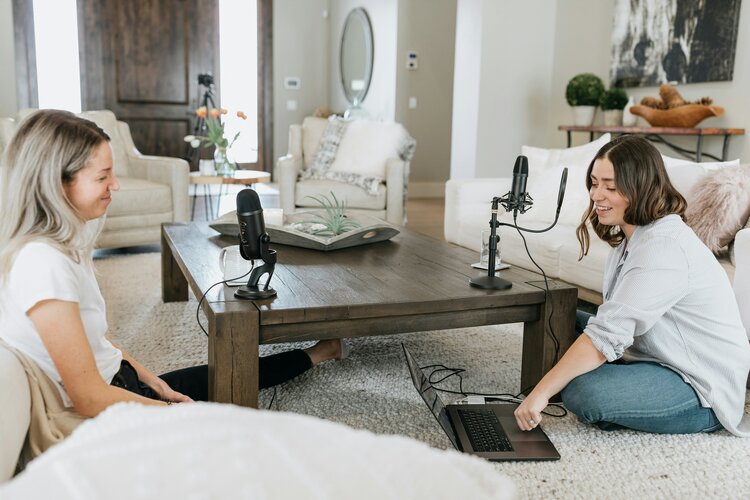Accessibility Options:
What's in this Guide?
Welcome to the Introduction to Podcasting guide! This user-friendly resource covers everything you need to start and grow your podcast, from understanding the basics and choosing the right equipment to planning, recording, editing, and publishing your episodes. Learn how to promote and monetize your podcast with practical tips and strategies, and explore a curated list of further reading to deepen your knowledge.

Best Podcasts for Podcasters
Subject Specialist
Choosing Your Topic
Before you start recording your podcast, it's essential to think about what you want to talk about and how you want to present it. Always have a script or outline, even if you plan to speak off the cuff. The script can serve as an outline to organize your talking points and ensure you cover all the key topics. Choose a subject you are passionate about, as your enthusiasm will make your podcast more engaging. Consider your target audience and think about what interests them and what they enjoy listening to. When you record your podcast, be authentic and genuine. This will help your listeners feel connected to you and encourage them to keep tuning in.

Resources to Getting Started
- How to Start a Podcast
Learn how to start a podcast, launch your show and start growing! This complete step-by-step beginners guide goes from initial idea, to going live, to snagging your first 100 listeners. - Everything You Need to Know to Start a Podcast
A step-by-step guide to getting started in the world of podcasting.
Outlining the Content
- Define purpose, topics, and target audience.
- Identify sections: intro, main content, interviews, conclusion.
- Research and gather accurate information.
- Organize main points logically.
- Add supporting subpoints or examples.
- Plan smooth transitions between segments.
- Include engaging elements like anecdotes or audio clips.
- Decide episode length.
- Revise and refine the outline for clarity.
- When ready, start recording your podcast episode.
7 popular podcast formats: Which one is right for you?
Equipment Fundamentals: How to Start a Podcast 2020: Podcasting for Beginners
Types of Microphones
Choosing the right microphone for recording is crucial to achieving professional-quality audio. There are three main types of microphones to consider: condenser, dynamic, and USB microphones.
Condenser microphones require a special power source called phantom power (48v), usually provided by audio interfaces. They capture subtle details and produce a very clear sound, making them ideal for studio recordings.
Dynamic microphones have a warm sound and do not need phantom power. They are very durable and can handle loud sounds well, making them a popular choice for live performances.
USB microphones are incredibly easy to use because they don’t need additional equipment. You just plug them directly into your computer and start recording. They are perfect for podcasting and beginners.
Each type of microphone has its own advantages, so the best choice depends on factors like your recording environment, purpose, and preferred sound. It's all about finding the microphone that fits your needs.
Avoiding Popping Sounds
When you're speaking into a microphone, it's important to prevent unwanted plosive sounds. Plosives happen when a strong burst of air hits the microphone, usually when you emphasize "b" or "p" sounds in certain words. To avoid this, you can position the microphone about 45 degrees to the side of your mouth, so the plosives don't go directly into it. Another solution is to use a pop filter, which helps reduce or even eliminate popping sounds caused by fast-moving air hitting the microphone during speech or singing.

On Campus Resources
- Creative Studio Music Equipment Catalog
As a University of Miami patron, you can borrow audio equipment from the music library for free. Simply reserve the equipment you need online and once you receive confirmation, you can pick it up at the library. - Creative Studio Audio Production Booth Reservation
The Audio Production Booths are located on the second floor of the music library. They are available on weekdays during two time blocks: from 9am to 12pm and 1:30pm to 4:30pm. As a University of Miami patron, you can reserve these booths and use them for various audio production projects, including music composition or podcast recording.
Working with an Audio Interface
To connect the microphone to the audio interface, you use a special cable called an XLR cable. If you have more than one microphone, you need an audio interface with extra spots for the cables. Once everything is connected, you use a USB cable to connect the audio interface to your computer.

The audio interface lets you control how loud the microphone is, so you can make sure it sounds just right. It's important to find the right balance, not too loud or too quiet.
Acoustic Treatment
- Free Ways to Reduce Echo for Better Sound Quality and Recording
- This video explores ways to improve the acoustical treatment using materials commonly found around the house such as pillows and blankets.
- Do You Need Soundproofing For Your Podcast?
- This video offers a different perspective on the need for soundproofing.
BEST Podcast Headphones (for any budget)
Introduction to Editing
The editing stage in podcast recording is when you refine and enhance your recorded audio to ensure it sounds polished and professional. Using editing software like Audition, Audacity, or GarageBand, you can remove mistakes or awkward pauses, adjust volume levels, and add background music or sound effects. This process helps to create a smooth and engaging final product that provides a better listening experience for your audience.
Downloadable Editing Software
- Adobe Creative Cloud
Adobe Creative Cloud (CC) is available at no cost to all active University of Miami faculty, staff, and students. Adobe CC gives you access to a collection of Adobe applications for Graphic Design, Video Editing, Web Development, Photography, and Cloud Services. With Adobe CC, there's something for everyone, and you don't have to be an expert to use it! - Audacity
Audacity is a free, easy-to-use, multi-track audio editor and recorder for Windows, macOS, GNU/Linux and other operating systems.
Basic Editing Techniques
Trimming Silence: Edit out long pauses or awkward silences to keep the pacing of your podcast smooth and engaging.
Adjusting Volume Levels: Ensure consistent audio levels throughout your episode. Increase the volume if something is too quiet or decrease it if it's too loud. This helps maintain a balanced listening experience.
Adding Music and Sound Effects: Spice up your podcast by incorporating background music or sound effects. They can set the mood, emphasize important points, or transition between segments.
Mixing and Fading: Blend different audio elements together by adjusting their levels. Use fading techniques to smoothly transition between music, segments, or guest interviews.
Exporting and Saving: After editing, export your podcast episode into a format that's suitable for sharing, such as MP3. Save your edited files with clear and organized names for easy access in the future.
Tips for Efficient Editing
Shortcut Keys: Learning shortcut keys in podcast production can help you edit faster and more efficiently. With just a few key presses, you can cut, paste, adjust volume, and perform editing tricks like a pro. It saves time and boosts your podcasting skills.
Saving Backups: Saving backups in podcast production is like having a safety net. It protects your hard work from unexpected disasters, like computer crashes or accidental file deletion. Backups ensure you never lose your podcast episodes, scripts, or valuable edits. It's like having a spare copy that you can rely on when things go wrong.
Developing a Workflow: Developing a workflow helps you stay organized and efficient throughout the process. From recording to editing and publishing, a workflow guides your steps, ensuring tasks are completed in the right order. It saves time, reduces stress, and helps you create high-quality podcasts with ease.
How To Edit A Podcast In Adobe Audition
Further Resources and Tutorials
- Audacity: Completely free, open sourced audio software that is compatible with both Mac and PC. Audacity has a moderate learning curve and the user interface is extremely dated, however, there are many tutorials online on how to use it and it is more than capable to produce professional sounding podcast productions.
- GarageBand: GarageBand is a software exclusively available on Mac computers. It comes pre-installed and is beginner-friendly, making it easy to learn. With its wide range of features, GarageBand is a great choice for audio production.
- Pixabay: Pixabay is a free stock photography and royalty-free stock media website. It is used for sharing photos, illustrations, vector graphics, film footage, music and sound effects, exclusively under the custom Pixabay license, which generally allows the free use of the material with some restrictions.
- Chosic: Chosic is a music library with downloadable music files free to use for commercial and non-commercial purposes.
- YouTube Studio: YouTube Studio is a platform provided by YouTube. By logging in, you can access YouTube Studio's Audio Library which will give you downloadable access to royalty free music and sound effects.
- Freesound: Freesound is a collaborative database of Creative Commons Licensed sounds. Browse, download and share sounds.
Adobe Podcast Speech Enhance
- Adobe Podcast Enhance
Adobe's speech enhancement platform that makes voice recordings sound as if they were recorded in a professional studio.
Adobe Podcast Speech Enhance Review
Choosing a Podcast Hosting Platform
Podcast hosting platforms are essential for hosting and distributing your podcast content. They provide secure storage for your audio files and generate an RSS feed containing episode information, facilitating distribution to platforms like Apple Podcasts and Spotify. These platforms also offer analytics to monitor your podcast's performance and audience engagement. You can customize your podcast website and player through these platforms, and some provide monetization options. They also handle technical support and infrastructure maintenance, freeing you to focus on content creation.
Here is a simplified process for considering a podcast hosting platform:
- Research: Explore different hosting platforms and compare their features, pricing, and user reviews.
- Consider your needs: Think about the size of your podcast, expected audience, storage requirements, analytics, and monetization options.
- Evaluate platform features: Look for essential features like RSS feed generation, episode management, customizable player, distribution to major podcast directories, and podcast website support.
- Pricing: Compare pricing plans and consider your budget, including any additional costs for storage or bandwidth.
- User-friendly interface: Ensure the platform has an intuitive and easy-to-use interface for uploading, scheduling episodes, and managing your podcast.
- Support and resources: Check if the platform offers reliable customer support and provides resources like tutorials or a knowledge base.
- Make a decision: Based on your research and considerations, choose the podcast hosting platform that best fits your needs and budget.
Tips for Promoting Your Podcast and Engaging with your Audience
- Utilize social media platforms to share episode releases, behind-the-scenes content, and engage with your audience.
- Collaborate with other podcasters, influencers, or relevant communities for cross-promotion opportunities.
- Consider creating a dedicated podcast website or blog to showcase your episodes and provide additional resources.
- Encourage listeners to leave reviews and ratings on podcast platforms.
- Respond to comments, questions, messages, and feedback from your audience.
- Consider hosting Q&A sessions, interviews, or listener contests to foster community engagement.
